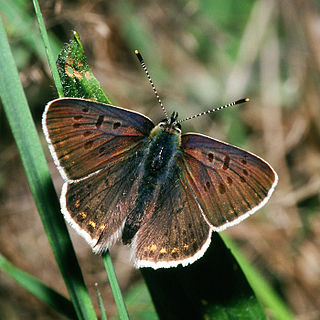
The chalkhill blue is a butterfly in the family Lycaenidae. It is a small butterfly that can be found throughout the Palearctic realm, where it occurs primarily in grasslands rich in chalk. Males have a pale blue colour, while females are brown. Both have chequered fringes around their wings.

The Adonis blue is a butterfly in the family Lycaenidae. It inhabits the Palearctic realm.

The purple-shot copper is a butterfly in the family of the Lycaenidae or copper butterflies and in the genus of the Lycaena.

Apatura ilia, the lesser purple emperor, is a species of butterfly native to most of Europe and east across the Palearctic. It is named for its similarity to the purple emperor butterfly.

Melitaea diamina, the false heath fritillary, is a butterfly of the family Nymphalidae.

The purple-edged copper is a butterfly of the family Lycaenidae.

Polyommatus eros, the Eros blue or common meadow blue, is a species of blue butterfly found in the Palearctic.

Glaucopsyche alexis, the green-underside blue, is a butterfly of the family Lycaenidae. It is found in the Palearctic.

Lycaena tityrus, the sooty copper, is a butterfly of the family Lycaenidae. It is found in Europe.

Pseudophilotes baton, the baton blue, is a butterfly of the family Lycaenidae. It is found in central and southern Europe and then east across the Palearctic to the Russian Far East.

Lysandra albicans, the Spanish chalk-hill blue, is a butterfly of the family Lycaenidae. It is found in Spain and Western North Africa.

Polyommatus amandus, the Amanda's blue, is a butterfly of the family Lycaenidae. It is found in the Palearctic realm.

Polyommatus damon, the Damon blue, is a butterfly of the family Lycaenidae.

Polyommatus daphnis, the Meleager's blue, is a butterfly of the family Lycaenidae.

Chazara briseis, the hermit, is a butterfly species belonging to the family Nymphalidae. It can be found in North Africa, southern Europe, Asia Minor, the Caucasus, Kazakhstan, Central Asia through Afghanistan, and north-western China and Tuva. It is found on steppe and in other dry grassy places between 500 and 2,500 meters.

Boloria pales, the shepherd's fritillary, is a butterfly of the family Nymphalidae. It is found from the Cantabrian Mountains and the Pyrenees through the Alps and Apennine Mountains east to the Balkan, Carpathian Mountains, the Caucasus and central Asia up to western China.

Polyommatus nivescens, the mother-of-pearl blue, is a species of butterfly in the family Lycaenidae. It is found in Spain. It is a small butterfly is sexual dimorphic. The upperside of the male is very clear, with just a bluish beige reflection bordered by a thin grey line and a marginal line of small grey dots. The female upperside is brown, decorated with a marginal line of large orange maculae bordering the hindwings and part of the forewings. Both have a white fringe. The underside is light ochre marked with a marginal line of white lunules topped with orange, and adorned with a line of black dots circled in white very marked on the fore.

Neolysandra coelestina is a butterfly found in the Palearctic that belongs to the blues family.

Polyommatus damone is a Palearctic butterfly in the Lycaenidae family.

Polyommatus venus is a butterfly in the family Lycaenidae. It was described by Otto Staudinger in 1886. The type locality is Kirghizia.





















